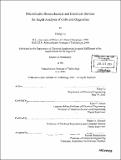| dc.contributor.advisor | Klavs F. Jensen and Martin A. Schmidt. | en_US |
| dc.contributor.author | Lu, Hang, 1977- | en_US |
| dc.contributor.other | Massachusetts Institute of Technology. Dept. of Chemical Engineering. | en_US |
| dc.date.accessioned | 2005-08-24T22:39:53Z | |
| dc.date.available | 2005-08-24T22:39:53Z | |
| dc.date.copyright | 2003 | en_US |
| dc.date.issued | 2003 | en_US |
| dc.identifier.uri | http://hdl.handle.net/1721.1/7996 | |
| dc.description | Thesis (Ph. D.)--Massachusetts Institute of Technology, Dept. of Chemical Engineering, 2003. | en_US |
| dc.description | Includes bibliographical references (p. 139-145). | en_US |
| dc.description.abstract | This thesis focuses on micro devices aimed at rapid analysis of cells and subcellular organelles. These devices take advantage of microfabrication techniques to create environment suitable for biomechanical and biochemical stimulation of cells, to break cell membranes to extract the intracellular materials, and to separate or concentrate organelles and proteins of interest. These procedures greatly reduce the amounts of samples and reagents necessary and the process time required from their macro counterparts. Moreover, they demonstrate operational advantages, such as lower voltages, less heating, and no significant gas formation in electrolysis, over their macroscopic counterparts. First in line of the process stream are a series of microfluidic devices developed for the purpose of studying cell adhesion on biomaterials. Numerical models are developed to aid the quantitative analysis of fluid shear stresses on cells in these devices. The experimental results demonstrate that these devices are capable of capturing ligand-density-dependent, shear-dependent, and growth-factor-dependent adhesion behavior of cell cultures. Next, two electrical microfluidic devices are developed for the purpose of cell lysis and organelle separation. Both devices are fabricated using electroplating techniques to create three-dimensional electrodes, and lithography to accommodate flexible designs in the fluid channels. Simple electrical models for cells and organelles are used to guide the design and operation of the miniaturized electroporation device that can successfully break open cells and release their content. | en_US |
| dc.description.abstract | (cont.) To study the isoelectric focusing field flow fractionation phenomena, another model combining flow calculation and reactive transport of amphoteric particles is used. The experimental results of organelle separation are in good agreement with predicted focusing behavior in the model. This technique is able to separate or concentrate organelles such as mitochondria and peroxisomes in a few minutes, which is greatly reduced from conventional techniques. Experiments demonstrate the separation of nuclei and whole cells from mitochondria. Additionally, the devices are used to distinguish mitochondria with intact membrane potential from those that have lost transmembrane potential. This ability to distinguish the mitochondria populations could potentially be used to assay whether cells have committed apoptosis via the mitochondrial pathway. The modules developed in this thesis demonstrate advantages of scaling down bioanalytical processes. Further developing and combining the technologies demonstrated in this thesis will enable a platform for parallel, fast, and automated cell dynamics and proteomics studies for systems biology. | en_US |
| dc.description.statementofresponsibility | by Hang Lu. | en_US |
| dc.format.extent | 145 leaves | en_US |
| dc.format.extent | 11321288 bytes | |
| dc.format.extent | 11321045 bytes | |
| dc.format.mimetype | application/pdf | |
| dc.format.mimetype | application/pdf | |
| dc.language.iso | eng | en_US |
| dc.publisher | Massachusetts Institute of Technology | en_US |
| dc.rights | M.I.T. theses are protected by copyright. They may be viewed from this source for any purpose, but reproduction or distribution in any format is prohibited without written permission. See provided URL for inquiries about permission. | en_US |
| dc.rights.uri | http://dspace.mit.edu/handle/1721.1/7582 | |
| dc.subject | Chemical Engineering. | en_US |
| dc.title | Microfluidic biomechanical and electrical devices for rapid analysis of cells and organelles | en_US |
| dc.type | Thesis | en_US |
| dc.description.degree | Ph.D. | en_US |
| dc.contributor.department | Massachusetts Institute of Technology. Department of Chemical Engineering | |
| dc.identifier.oclc | 53089061 | en_US |

